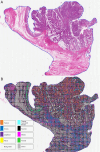The Glasgow Microenvironment Score: an exemplar of contemporary biomarker evolution in colorectal cancer
- PMID: 38853386
- PMCID: PMC11163018
- DOI: 10.1002/2056-4538.12385
The Glasgow Microenvironment Score: an exemplar of contemporary biomarker evolution in colorectal cancer
Abstract
Colorectal cancer remains a leading cause of mortality worldwide. Significant variation in response to treatment and survival is evident among patients with similar stage disease. Molecular profiling has highlighted the heterogeneity of colorectal cancer but has had limited impact in daily clinical practice. Biomarkers with robust prognostic and therapeutic relevance are urgently required. Ideally, biomarkers would be derived from H&E sections used for routine pathological staging, have reliable sensitivity and specificity, and require minimal additional training. The biomarker targets would capture key pathological features with proven additive prognostic and clinical utility, such as the local inflammatory response and tumour microenvironment. The Glasgow Microenvironment Score (GMS), first described in 2014, combines assessment of peritumoural inflammation at the invasive margin with quantification of tumour stromal content. Using H&E sections, the Klintrup-Mäkinen (KM) grade is determined by qualitative morphological assessment of the peritumoural lymphocytic infiltrate at the invasive margin and tumour stroma percentage (TSP) calculated in a semi-quantitative manner as a percentage of stroma within the visible field. The resulting three prognostic categories have direct clinical relevance: GMS 0 denotes a tumour with a dense inflammatory infiltrate/high KM grade at the invasive margin and improved survival; GMS 1 represents weak inflammatory response and low TSP associated with intermediate survival; and GMS 2 tumours are typified by a weak inflammatory response, high TSP, and inferior survival. The prognostic capacity of the GMS has been widely validated while its potential to guide chemotherapy has been demonstrated in a large phase 3 trial cohort. Here, we detail its journey from conception through validation to clinical translation and outline the future for this promising and practical biomarker.
Keywords: biomarkers; colonic cancer; histopathology; inflammation; microenvironment score; prognosis; rectal cancer; stromal invasion; subtypes; tumour microenvironment.
© 2024 The Authors. The Journal of Pathology: Clinical Research published by The Pathological Society of Great Britain and Ireland and John Wiley & Sons Ltd.
Figures






References
-
- Morgan E, Arnold M, Gini A, et al. Global burden of colorectal cancer in 2020 and 2040: incidence and mortality estimates from GLOBOCAN. Gut 2023; 72: 338–344. - PubMed
-
- Wittekind C, Compton C, Quirke P, et al. A uniform residual tumor (R) classification: integration of the R classification and the circumferential margin status. Cancer 2009; 115: 3483–3488. - PubMed
-
- Nagtegaal ID, Quirke P. What is the role for the circumferential margin in the modern treatment of rectal cancer? J Clin Oncol 2008; 26: 303–312. - PubMed
-
- Howlett CJ, Tweedie EJ, Driman DK. Use of an elastic stain to show venous invasion in colorectal carcinoma: a simple technique for detection of an important prognostic factor. J Clin Pathol 2009; 62: 1021–1025. - PubMed
Publication types
MeSH terms
Substances
LinkOut - more resources
Full Text Sources
Medical
Miscellaneous

